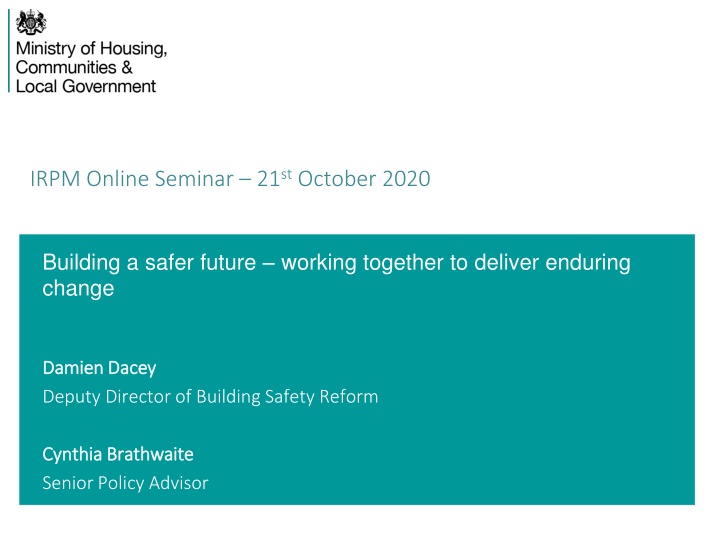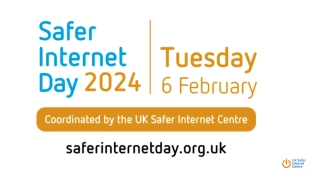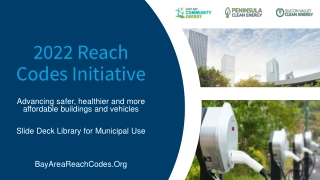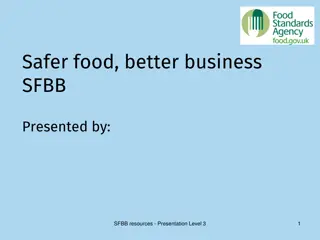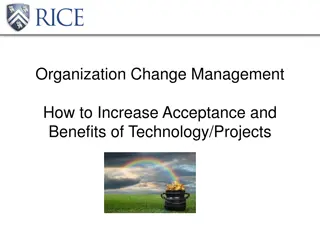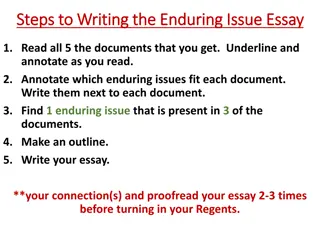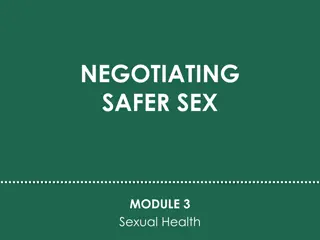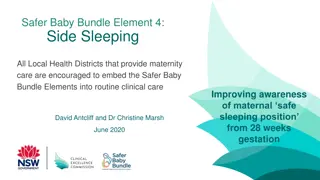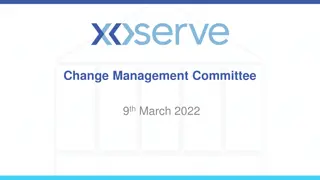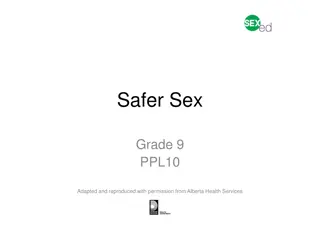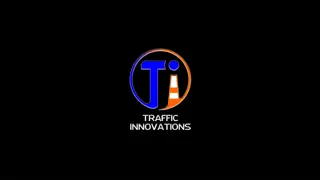Building a Safer Future: Delivering Enduring Change
This content discusses the upcoming Bill concerning building safety reform, focusing on establishing a new regulatory system, accountability, resident engagement, and other key aspects to ensure safer buildings. It outlines the timeline, pre-legislative scrutiny, and the contents of the Bill, providing valuable insights into the proposed changes and their implications for the future.
Download Presentation

Please find below an Image/Link to download the presentation.
The content on the website is provided AS IS for your information and personal use only. It may not be sold, licensed, or shared on other websites without obtaining consent from the author.If you encounter any issues during the download, it is possible that the publisher has removed the file from their server.
You are allowed to download the files provided on this website for personal or commercial use, subject to the condition that they are used lawfully. All files are the property of their respective owners.
The content on the website is provided AS IS for your information and personal use only. It may not be sold, licensed, or shared on other websites without obtaining consent from the author.
E N D
Presentation Transcript
IRPM Online Seminar 21st October 2020 Building a safer future working together to deliver enduring change Damien Dacey Damien Dacey Deputy Director of Building Safety Reform Cynthia Brathwaite Cynthia Brathwaite Senior Policy Advisor
Timeline Timeline The Bill was published on 20 July in draft form, to enable pre-legislative scrutiny. The HCLG Select Committee launched its call for written evidence which closed on the 14 September. The Committee is currently holding oral evidence sessions with key stakeholders. The report and recommendations will be published end of November. The extent of any recommended changes will dictate when the Bill will be ready to be introduced; the aim is to be ready as soon as possible in 2021. If things proceed as planned, we can expect the Bill to achieve Royal Assent by the end of 2021 at the latest. Alongside this, we are working with the HSE on setting up the Building Safety Regulator, and on transition planning - the necessary secondary legislation will be laid after Royal Assent as required and to ensure an orderly transition. 2
Pre Pre- -Legislative Scrutiny Legislative Scrutiny The HCLG Select Committee has set out the areas it is seeking scrutiny on: How well does the Bill, as drafted, meet the Government s own policy intentions? Does it establish an appropriate scope for the new regulatory system? Will the Bill provide for a robust and realistic system of accountability for those responsible for building safety? Are the sanctions strong enough? Will the Bill provide strong mechanisms to ensure residents are listened to if they have concerns about their building s safety? Is the Government right to propose a new Building Safety Charge? Does the Bill introduce sufficient protections to ensure that leaseholders do not face excessive charges and that their funds are properly managed? Does the Bill improve the product testing regime in a way that will command the full confidence of the sector? Is it right that the new Building Safety Regulator be established under the Health and Safety Executive, and how should it be funded? Does the Bill present an opportunity to address other building safety issues, such as requirements for sprinkler systems? 3
Overview Overview Contents of the Bill Contents of the Bill An overview of the Bill Part 1 Establishes a new Building Safety Regulator within the Health and Safety Executive. Defines the scope of the regime with respect to the definition of risks and creates a power to set out in secondary legislation the buildings that are included in that scope. Part 2 Amends the Building Act 1984 (for England), to sets out the new regulatory regime during the design and construction phase for buildings in scope Puts in place requirements for registration of building inspectors and building control approvers to improve competence levels in the building control sector. Part 3 Sets out requirements for higher risk buildings when they are occupied, including duties on the Accountable Person (the duty holder in occupation) and building safety managers in relation to building safety risks in their building. Part 4 Provisions requiring developers to belong to a New Homes Ombudsman scheme. Powers to regulate construction products (through statutory instruments). Increased powers for the Architect Registration Board to monitor the competence of architects. Removal of the democratic filter which requires social housing residents to refer unresolved complaints to a designated person or wait eight weeks before they can access redress via the Housing Ombudsman. Part 5 4
Part 2 Part 2 - - The Regulator and its Functions The Regulator and its Functions Establishes a new Building Safety Regulator within the Health and Safety Executive. Defines the scope of the regime with respect to the definition of risks and creates a power to set out in secondary legislation the buildings that are included in that scope. The Bill establishes the Health and Safety Executive as the Building Safety Regulator, with three broad functions: Implementing the new regime for higher risk buildings, acting as the building control authority for higher risk buildings and overseeing and enforcing the new regime in occupation for higher risk buildings. Overseeing the safety and performance of all buildings. This involves overseeing the performance of other building control bodies (local authorities and registered building control approvers (currently known as Approved Inspectors), and advising on existing and emerging building standards and safety risks Assisting and encouraging competence among the built environment industry, and registered building inspectors. This involves establishing and setting strategic direction of the proposed industry-led competence committee and establishing a unified building control profession with competence requirements for registration as a building control professional. This part also provides two key statutory definitions, for building safety risk and higher risk building . And creates the power for the SofS to amend both these definitions in light of evidence, of advice from the Building Safety Regulator. For day one, we intend to make regulations to define higher risk buildings as covering all multi-occupied residential buildings of 18 metres or more in height, or more than six storeys (whichever is reached first). 5
Part 3 Part 3 Building Act 1984 Building Act 1984 Amends the Building Act 1984 (for England), to sets out the new regulatory regime during the design and construction phase for buildings in scope Puts in place requirements for registration of building inspectors and building control approvers to improve competence levels in the building control sector. This part includes amendments to the Building Act 1984, to: allow the Building Safety Regulator to act as the building control authority for higher risk buildings; provide powers for building regulations to set out the detailed regime for higher risk buildings. Building Regulations will be used to establish the gateways process for the design, construction and refurbishment of buildings in scope, and establish the regime for dutyholders; put in place requirements for the registration of building inspectors and building control approvers (formerly known as Approved Inspectors); and put in place powers for the Secretary of State, advised by the Building Safety Regulator, to act where a Local Authority is exercising its building control functions below the standard expected. 6
Part 4 Part 4 Higher Risk Buildings Higher Risk Buildings Sets out requirements for higher risk buildings when they are occupied, including duties on the Accountable Person (the duty holder in occupation) and building safety managers in relation to building safety risks in their building. This part includes provisions relating to the management of buildings in occupation, including: Defining the Accountable Person and Building Safety Manager; Putting in place requirements for registering a building, and applying for a Building Assurance Certificate; Putting in place requirements for the ongoing management of safety, and information to be held as part of the golden thread of safety information; Putting in place requirements for the ongoing engagement with residents, and for the obligations on residents in relation to the safe management of buildings; and Measures around the recovery of costs, special measures (where an AP is not able to fulfil their duties) and enforcement of the regime. 7
Part 5 Part 5 Supplementary and General Supplementary and General Provisions requiring developers to belong to a New Homes Ombudsman scheme. Powers to regulate construction products (through statutory instruments). Increased powers for the Architect Registration Board to monitor the competence of architects. Removal of the democratic filter which requires social housing residents to refer unresolved complaints to a designated person or wait eight weeks before they can access redress via the Housing Ombudsman. This part includes provisions that are complementary to the new regime for higher risk buildings in scope, including: Provisions requiring the SofS to ensure that a New Homes Ombudsman scheme is available, and a power to make regulations requiring developers of new build homes within scope to join the scheme; Powers for the SofS to create a statutory list of safety critical construction products, and require construction products that are not covered by the existing regime or included on the statutory list to be safe products; Provisions allowing disciplinary orders made by the Architect Registration Board to be listed alongside an architect s entry in the Register of architects; and A provision enabling social housing complainants to escalate a complaint to the Housing Ombudsman service directly, by removing the existing requirement ( the democratic filter ) to make their complaint via a `designated person . 8
Major Areas to be added to the Bill Major Areas to be added to the Bill Government expert Michael Wade has been asked to test and recommend funding solutions to protect leaseholders from unaffordable costs of fixing historic defects, ensuring the burden does not fall ontaxpayers; The Home Office published a Fire Safety Consultation which closed on the 12th of October, with proposals to strengthen the Regulatory Reform (Fire Safety) Order 2005 and improve compliance for all regulated buildings, as well as to implement the Grenfell Tower Inquiry Phase 1 report recommendations which require a change in law. Grenfell Tower Inquiry MHCLG will continue to monitor emerging findings from Phase 2, and incorporate changes where appropriate and possible. Over the next year, areas the Inquiry will look at are expected to include management of the Building, including safety management and communication with residents, and the role of Government. 9
Building Safety Manager Building Safety Manager The Accountable Person will be under a statutory duty to appoint either a corporate body, or manager from within their own organisation to act as a Building Safety Manager. The Regulator has the power to veto that appointment and can direct the Accountable Person to remove their BSM if it transpires that they are not carrying out the functions to an acceptable standard. The nominated individual must have the relevant skills, knowledge and experience and named on the Building Assurance Certifcate. The Regulator will have the power to issue guidance on how to assess the SKEB of BSM. This is to ensure that those supporting the Accountable Person in carrying out its duties under Part 4 is competent to carry out that work in line with the legislation. The Bill puts a number of statutory obligations on the Building Safety Manager namely: Implement the building safety case; Report mandatory occurrences to the Regulator; Operate the resident s complaints system. 10
Assessment of building safety risks Assessment of building safety risks The duties on the Accountable Person include carrying out an assessment of building safety risks in and around the building and taking all necessary steps to control those risks To achieve this the Accountable Person will have to: identify the hazards within their building, decide who might be harmed by those hazards, evaluate the likelihood and consequence of those hazards becoming a major incident, decide on the measures needed to lower the risks of the hazards becoming a major accident to an acceptable level, implement them, and have a system in place to ensure those measures remain fit for purpose whilst the building is occupied. 11
Safety Case Requirements Safety Case Requirements by BSM 12
Engagement with residents Engagement with residents The Accountable Person will be required to proactively provide an accessible summary of building safety information to all residents in the building, regardless of tenure as well as provide further and more detailed information to a resident on request. The Accountable Person must establish a complaints process for residents, guests and visitors to raise safety concerns and handle these complaints in line with that process. The BSM will be required to operate this system. The Regulator must establish and operate a complaints procedure to handle resident safety concerns escalated to them either directly by the resident or via the Accountable Person. 13
Building Safety Charge Building Safety Charge The Bill amends the Landlord and Tenant Act 1985 allowing for a supplementary charge to in relation to works carried out under the Bill to be recovered alongside the service charge. The mechanism mirrors the well-established processes for recovery of major works costs and allows for leaseholders to challenge the reasonableness of costs. As with a service charge, the building safety charge must be held on trust for the benefit of leaseholders and must be accounted for in a proportionate and transparent way. Secondary legislation will set out time limits and the types of works that can be recharged to leaseholders, such as production of the safety case and the appointment of the building safety manager. 14
Key Links Key Links The Bill can be found at: https://www.gov.uk/government/publications/draft-building-safety-bill Alongside this (and linked from the same page) The explanatory notes provide a detailed description of each clause; and The impact assessment covers the expected costs, benefits and impact on Government, individuals and those involved in the design, construction, maintenance and management of buildings. The final report of the Competence Steering Group is available at https://www.ife.org.uk/IFE-News/setting-the-bar-the-final-report-of-the- competence-steering-group 15
Thank you Damien Dacey Deputy Director Ministry of Housing, Communities and Local Government Cynthia Brathwaite Senior Policy Advisor Ministry of Housing, Communities and Local Government
